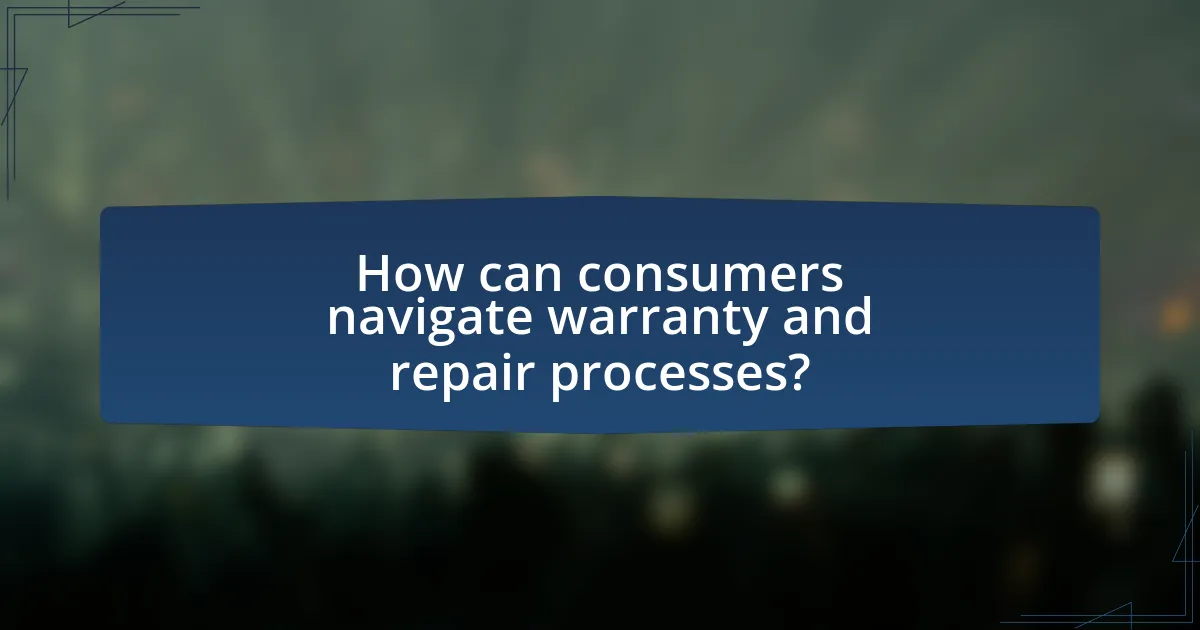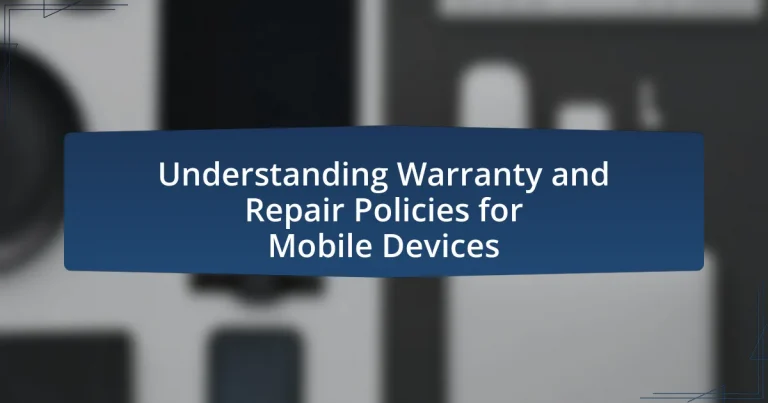Warranty and repair policies for mobile devices are essential for consumers to understand, as they outline the coverage for defects in materials and workmanship typically for one year from the purchase date. These policies vary among manufacturers, with differences in duration, coverage, and claims processes. Common terms include limitations on coverage, conditions for claims, and exclusions, while warranty periods differ by device type. The article also addresses the types of repairs covered, the distinction between manufacturer defects and accidental damage, and the importance of understanding these policies to avoid unexpected costs. Additionally, it provides guidance on navigating warranty claims, maintaining warranty validity, and best practices for consumers to ensure they receive the support they are entitled to.

What are Warranty and Repair Policies for Mobile Devices?
Warranty and repair policies for mobile devices typically cover defects in materials and workmanship for a specified period, usually one year from the date of purchase. These policies often include options for repair or replacement of the device at no cost to the consumer if the issue falls under warranty terms. For example, manufacturers like Apple and Samsung provide limited warranties that specify conditions under which repairs are covered, such as hardware failures but exclude accidental damage. Additionally, many companies offer extended warranty plans or insurance that cover accidental damage and other issues beyond the standard warranty.
How do warranty policies differ among mobile device manufacturers?
Warranty policies among mobile device manufacturers vary significantly in terms of duration, coverage, and conditions. For instance, Apple typically offers a one-year limited warranty that covers manufacturing defects but excludes accidental damage, while Samsung provides a similar one-year warranty with additional options for extended coverage through Samsung Care+. Furthermore, some manufacturers, like Google, offer a two-year warranty on their devices, which includes coverage for hardware defects. Additionally, the process for claiming warranty service can differ; Apple requires users to visit an Apple Store or authorized service provider, whereas other brands may offer mail-in service options. These differences highlight the importance of understanding each manufacturer’s specific warranty terms and conditions before purchasing a device.
What are the common terms and conditions found in warranty policies?
Common terms and conditions found in warranty policies typically include coverage duration, limitations on coverage, conditions for claims, and exclusions. Coverage duration specifies the time frame during which the warranty is valid, often ranging from one year to several years. Limitations on coverage outline specific scenarios or damages that are not covered, such as accidental damage or misuse. Conditions for claims require the customer to provide proof of purchase and may necessitate that the product be returned to the manufacturer or authorized service center for evaluation. Exclusions detail specific components or situations that are not covered under the warranty, such as wear and tear or modifications made to the device. These elements are standard in warranty policies to ensure clarity and protect both the consumer and the manufacturer.
How do warranty periods vary by device type?
Warranty periods vary significantly by device type, with smartphones typically offering one to two years, laptops ranging from one to three years, and tablets generally providing one to two years. For instance, major smartphone manufacturers like Apple and Samsung commonly provide a one-year warranty, while some laptops, especially from brands like Dell and Lenovo, may offer extended warranties of up to three years, reflecting the complexity and cost of the devices. Tablets often align with smartphone warranties, but premium models may have longer coverage. This variation is influenced by factors such as device complexity, manufacturing costs, and market competition, which dictate the warranty terms set by manufacturers.
What types of repairs are typically covered under warranty?
Repairs typically covered under warranty include defects in materials and workmanship, such as malfunctioning hardware components, screen defects, and battery failures. These repairs are generally provided at no cost to the consumer within the warranty period, which usually lasts from one to two years, depending on the manufacturer. For instance, Apple’s warranty covers hardware repairs for manufacturing defects, while Samsung offers similar coverage for their devices.
What constitutes a manufacturer defect?
A manufacturer defect occurs when a product is flawed due to errors in the design, production, or assembly process, leading to a failure to meet quality standards. This can include issues such as faulty components, improper assembly, or design flaws that make the product unsafe or unusable. For example, if a smartphone has a battery that overheats due to a design flaw, this would be classified as a manufacturer defect. Such defects are typically covered under warranty policies, as they indicate that the product did not perform as intended due to the manufacturer’s negligence.
Are accidental damages covered by warranty policies?
Accidental damages are generally not covered by standard warranty policies. Warranty policies typically cover defects in materials and workmanship, but they exclude damages resulting from accidents, misuse, or unauthorized repairs. For example, a study by the Consumer Electronics Association indicates that most manufacturers specify in their warranty terms that accidental damage is not included, emphasizing the distinction between manufacturing defects and user-inflicted damage.
Why is it important to understand warranty and repair policies?
Understanding warranty and repair policies is crucial because it informs consumers of their rights and responsibilities regarding product defects and repairs. Knowledge of these policies enables users to make informed decisions about their purchases, ensuring they can seek repairs or replacements when necessary. For instance, a study by Consumer Reports indicates that 30% of consumers are unaware of their warranty coverage, which can lead to unexpected costs when devices malfunction. Therefore, comprehending these policies helps consumers avoid financial loss and ensures they receive the support they are entitled to from manufacturers.
How can understanding these policies save consumers money?
Understanding warranty and repair policies for mobile devices can save consumers money by enabling them to make informed decisions about repairs and replacements. When consumers are aware of the specifics of their warranty coverage, such as what damages are included and the duration of the coverage, they can avoid unnecessary out-of-pocket expenses. For instance, a study by Consumer Reports found that 60% of consumers who understood their warranty terms were able to utilize their coverage effectively, resulting in savings of up to $200 on average for repairs. Additionally, knowing the repair policies can help consumers choose the most cost-effective service options, preventing them from paying for services that are already covered under warranty.
What role do warranty policies play in consumer rights?
Warranty policies serve as a crucial component of consumer rights by providing legal assurances that products will function as promised for a specified period. These policies protect consumers from defects and malfunctions, ensuring they receive repairs, replacements, or refunds when products fail to meet quality standards. For instance, under the Magnuson-Moss Warranty Act in the United States, consumers are entitled to clear information about warranty terms, which reinforces their rights to seek recourse when products do not perform as expected. This legal framework empowers consumers, ensuring they are not left vulnerable to faulty products and enhancing their overall purchasing confidence.

How can consumers navigate warranty and repair processes?
Consumers can navigate warranty and repair processes by thoroughly understanding the terms of their warranty, documenting issues, and following the manufacturer’s procedures for repairs. First, consumers should read the warranty documentation to know what is covered, the duration, and any specific conditions that must be met for claims. Next, they should keep detailed records of any problems, including dates, descriptions, and any communications with customer service. Following the manufacturer’s outlined steps for initiating a repair, such as contacting customer support or visiting authorized service centers, is crucial for a smooth process. According to a survey by Consumer Reports, 70% of consumers who followed these steps reported a satisfactory resolution to their warranty claims, highlighting the importance of adherence to established procedures.
What steps should consumers take to file a warranty claim?
Consumers should follow these steps to file a warranty claim: first, locate the warranty information provided at the time of purchase, which typically includes the warranty period and coverage details. Next, gather necessary documentation such as the original receipt, warranty card, and any relevant product information. After that, contact the manufacturer or retailer’s customer service to initiate the claim process, providing them with the gathered documentation. Finally, follow any specific instructions given by the customer service representative, which may include shipping the product for inspection or visiting a designated service center. These steps ensure that consumers effectively navigate the warranty claim process for mobile devices.
What documentation is required for a warranty claim?
To file a warranty claim, the required documentation typically includes the original purchase receipt, the warranty registration (if applicable), and a detailed description of the issue. The original purchase receipt serves as proof of purchase and verifies that the product is still under warranty. The warranty registration may provide additional information about the coverage period and terms. A detailed description of the issue helps the manufacturer or retailer assess the claim accurately. These documents are essential for validating the warranty claim process and ensuring a smooth resolution.
How long does the warranty claim process typically take?
The warranty claim process typically takes between a few days to several weeks, depending on the manufacturer and the complexity of the claim. For instance, many manufacturers aim to resolve claims within 14 to 30 days, as indicated by industry standards. Factors such as the need for parts replacement, verification of the claim, and shipping times can extend this duration.
What should consumers do if their warranty claim is denied?
Consumers should first review the warranty terms to understand the reasons for the denial. If the denial appears unjustified, consumers can gather supporting documentation, such as receipts and correspondence, to contest the decision. Following this, they should contact the manufacturer or retailer’s customer service to discuss the claim further. If the issue remains unresolved, consumers may escalate the matter by filing a complaint with consumer protection agencies or seeking legal advice. This process is supported by the fact that many warranty disputes can be resolved through clear communication and documentation.
What are the common reasons for warranty claim denials?
Common reasons for warranty claim denials include lack of proof of purchase, damage caused by misuse or accidents, and claims made after the warranty period has expired. Specifically, manufacturers often require a receipt to validate the warranty, and if the device shows signs of physical damage or improper use, the claim may be rejected. Additionally, if the warranty period has lapsed, any claims submitted will not be honored, as stated in the warranty terms.
How can consumers appeal a denied warranty claim?
Consumers can appeal a denied warranty claim by first reviewing the warranty terms and conditions to understand the basis for the denial. After identifying the reasons for the denial, consumers should gather supporting documentation, such as receipts, warranty registration, and any correspondence with the manufacturer or retailer. Next, consumers should contact the warranty provider, clearly stating their case and providing the gathered evidence to support their appeal. If the initial appeal is unsuccessful, consumers can escalate the issue by requesting a supervisor review or contacting consumer protection agencies for further assistance. This process is supported by the fact that many manufacturers have formal appeal procedures outlined in their warranty documentation, which consumers can utilize to strengthen their case.

What are the best practices for maintaining mobile device warranties?
To maintain mobile device warranties effectively, users should adhere to the manufacturer’s guidelines, keep proof of purchase, and avoid unauthorized repairs. Following the manufacturer’s instructions ensures compliance with warranty terms, as most warranties require users to operate the device according to specified guidelines. Retaining the original receipt or invoice serves as essential proof of purchase, which is often necessary for warranty claims. Additionally, unauthorized repairs can void warranties, as manufacturers typically stipulate that only certified technicians should perform repairs. These practices are supported by warranty policies from major manufacturers, which explicitly outline the importance of adhering to guidelines and maintaining documentation for warranty validity.
How can consumers ensure their warranty remains valid?
Consumers can ensure their warranty remains valid by adhering to the manufacturer’s guidelines and maintaining proper documentation. This includes keeping the original purchase receipt, registering the product if required, and following the specified usage and care instructions outlined in the warranty terms. Additionally, consumers should avoid unauthorized repairs or modifications, as these actions can void the warranty. According to the Federal Trade Commission, warranties are legally binding agreements, and failure to comply with the stated conditions can result in the loss of warranty coverage.
What maintenance tips help prevent warranty voiding?
To prevent warranty voiding, regularly follow the manufacturer’s maintenance guidelines, including using approved accessories and software updates. Adhering to these guidelines ensures that the device remains in compliance with warranty terms. For instance, using non-certified chargers can lead to damage that voids the warranty, as manufacturers often specify compatible accessories to maintain device integrity. Additionally, keeping the device clean and avoiding exposure to extreme conditions, such as excessive moisture or heat, further protects against damage that could result in warranty claims being denied.
How important is it to keep receipts and documentation?
Keeping receipts and documentation is crucial for warranty claims and repair processes for mobile devices. These documents serve as proof of purchase, which manufacturers and service providers often require to validate warranty coverage. For instance, a study by the Consumer Electronics Association indicates that 70% of warranty claims are denied due to lack of proper documentation. Therefore, retaining receipts and related paperwork ensures that consumers can effectively exercise their rights under warranty policies and facilitates smoother repair processes.
What common mistakes should consumers avoid regarding warranties?
Consumers should avoid assuming that all damages are covered under warranties. Many warranties have specific exclusions, such as accidental damage or wear and tear, which consumers often overlook. For instance, a study by the Consumer Product Safety Commission found that 30% of consumers mistakenly believed their warranty covered accidental damage, leading to unexpected repair costs. Additionally, failing to read the warranty terms thoroughly can result in misunderstandings about the coverage period and required maintenance, which are critical for maintaining warranty validity.
How can misunderstanding warranty terms lead to issues?
Misunderstanding warranty terms can lead to significant issues, such as unexpected repair costs or denial of service. When consumers misinterpret the coverage, limitations, or duration of a warranty, they may assume that certain damages or malfunctions are covered when they are not. For instance, a study by the Consumer Product Safety Commission found that 30% of consumers were unaware of specific exclusions in their warranties, leading to disputes with manufacturers. This lack of clarity can result in frustration, financial loss, and a negative customer experience, as individuals may be left to pay for repairs that they believed were included under warranty.
What are the risks of using unauthorized repair services?
Using unauthorized repair services poses significant risks, including voiding manufacturer warranties, compromising device safety, and potentially leading to further damage. When a device is repaired by an unauthorized service provider, the original warranty is often rendered invalid, meaning that any future repairs or replacements covered under the warranty will not be honored. Additionally, unauthorized technicians may lack the necessary training and expertise, which can result in improper repairs that compromise the device’s functionality and safety. For instance, using non-genuine parts can lead to overheating or battery malfunctions, posing safety hazards. Furthermore, unauthorized repairs can lead to data loss or breaches, as these technicians may not adhere to proper data protection protocols.
What are some practical tips for dealing with warranty and repair issues?
To effectively deal with warranty and repair issues, first, always read the warranty policy thoroughly to understand coverage and limitations. This ensures that you are aware of what is included, such as parts, labor, and specific conditions that may void the warranty. Next, document all communications with the manufacturer or repair service, including dates, names, and details of conversations, as this can serve as evidence if disputes arise. Additionally, keep receipts and records of any repairs or services performed, as these can be crucial for warranty claims. Finally, if issues persist, escalate the matter by contacting higher-level customer service or consumer protection agencies, as they can provide additional support and guidance.





